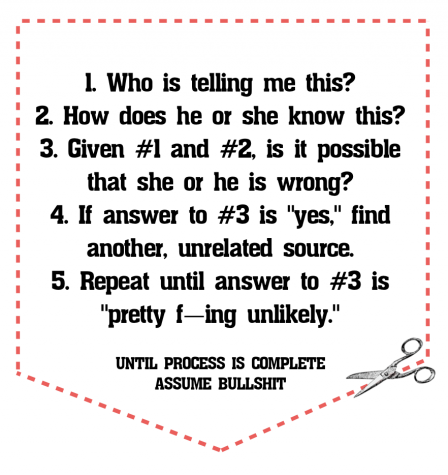The Pocket Guide to Bullshit Prevention by Michelle Nijhuis.
From the post:
I am often wrong. I misunderstand; I misremember; I believe things I shouldn’t. I’m overly optimistic about the future quality of Downton Abbey, and inexact in my recall of rock-star shenanigans. But I am not often—knock wood—wrong in print, and that’s because, as a journalist, I’ve had advanced training in Bullshit Prevention Protocol (BPP).
Lately, as I’ve watched smarter and better-dressed friends believe all manner of Internet nonsense, I’ve come to appreciate my familiarity with BPP. Especially because we’re all publishers now. (Sharing a piece of news with 900 Facebook friends is not talking. It’s publishing.) And publishing bullshit is extremely destructive: It makes it harder for the rest of us to distinguish between bogus news and something real, awful, and urgent.
While BPP is not failsafe, generations of crotchety, underpaid, truth-loving journalists have found that it dramatically reduces one’s chances of publishing bullshit.
So I believe that everyone should practice BPP before publishing. No prior experience is required: Though it’s possible to spend a lifetime debating the finer points of BPP (and the sorely-needed news literacy movement wants high-school and college students to spend at least a semester doing so) its general principles, listed in a handy, portable, and free—free!—form above, are simple.
Here’s how they work in practice.
…
This rocks!
Michelle’s post is a must read to get the maximum benefit from the Pocket Guide to Bullshit Prevention (PGBP).
If I could equip every librarian with one and only one resource for evaluating technologies, it would be this pocket guide.
The 49 words of the PGBP will serve you better than any technology review, guide, article, or testimonial.
It takes effort on your part but the choice is effort on your part or your being taken advantage of by others.
Your call.
I first saw this in a tweet by Neil Saunders.
